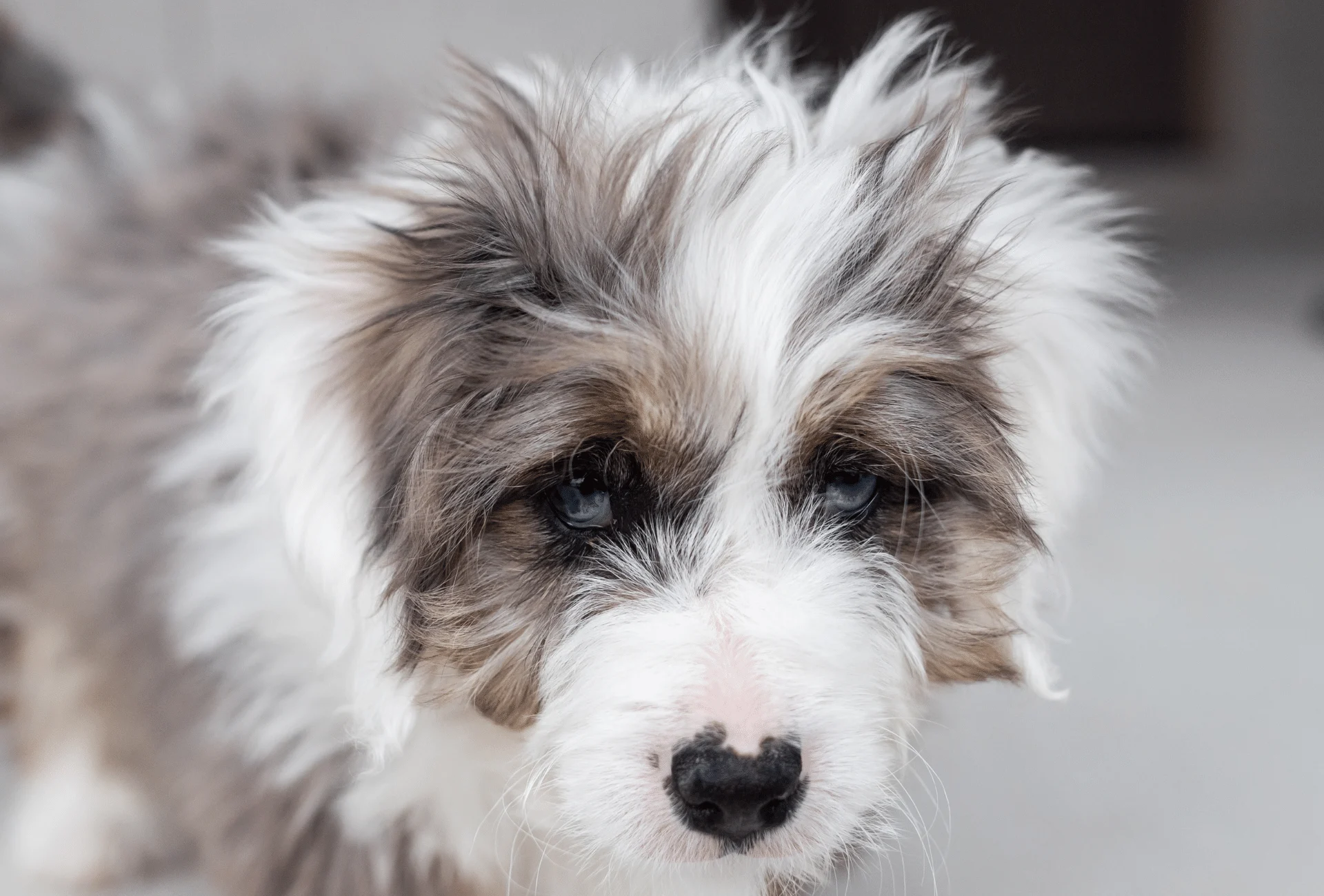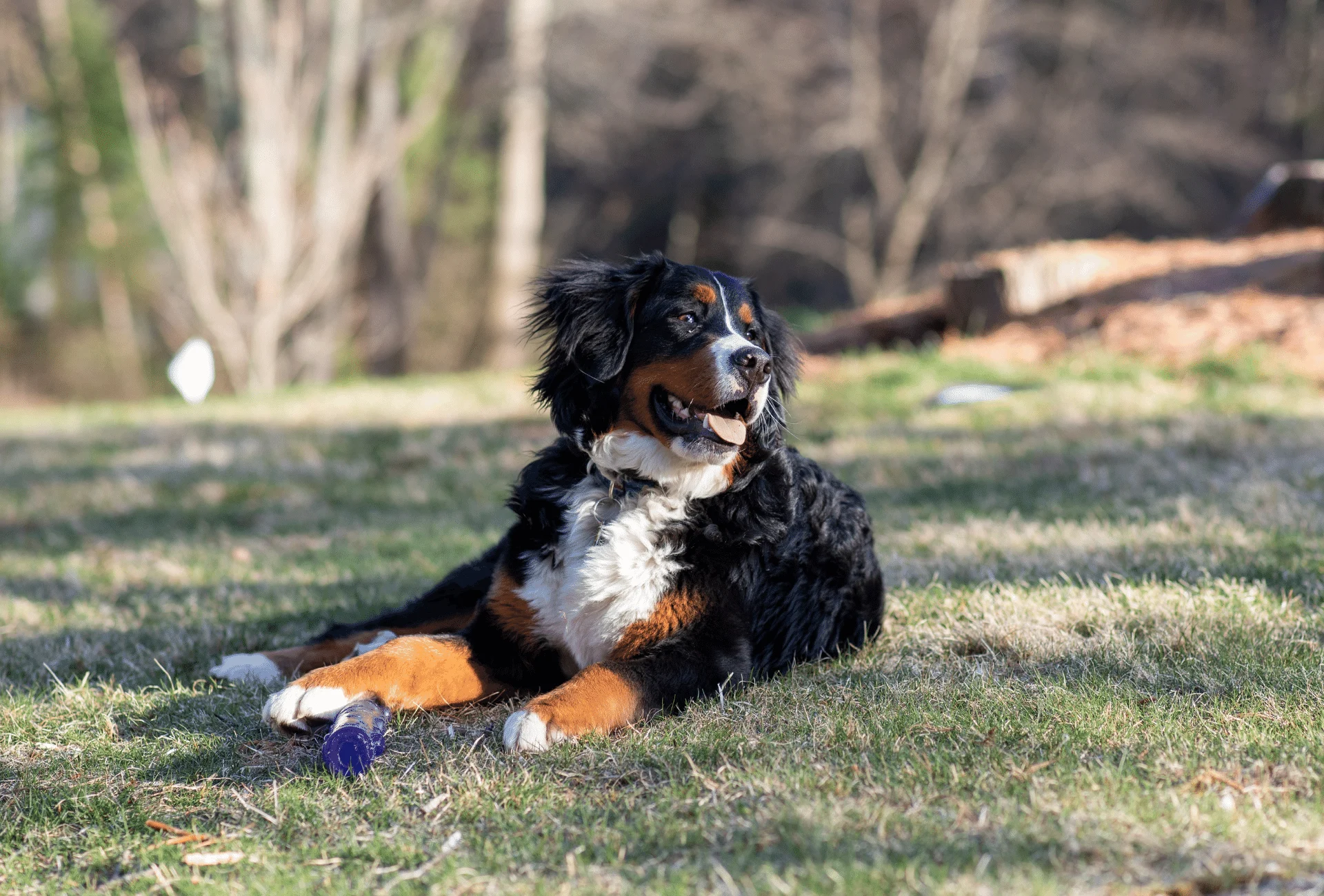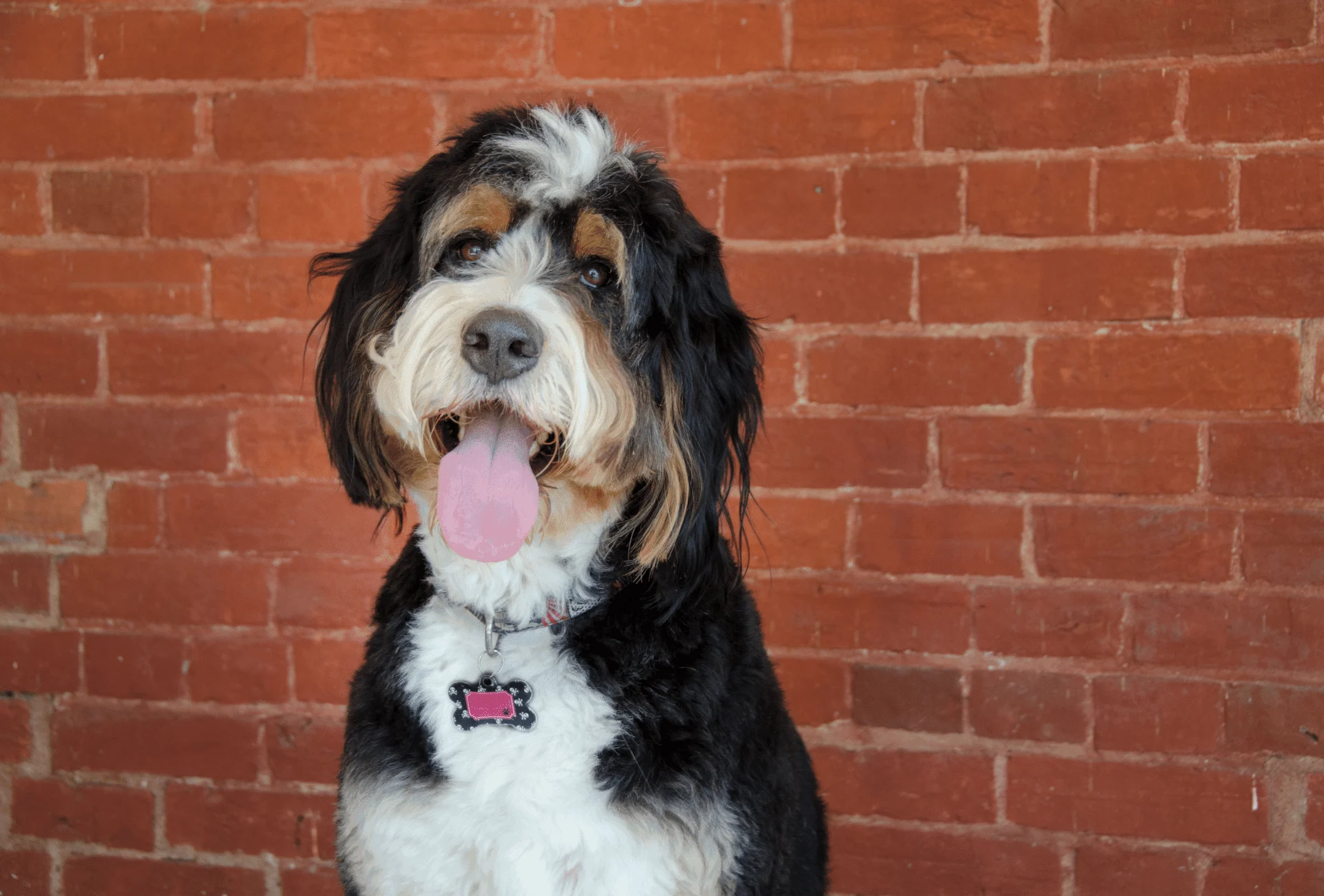Cross arguably the second most intelligent dog breed on earth with the watchful Bernese Mountain Dog, and you’re left with the ever-popular Bernedoodle.
Where did this mix come from, and is it right for you?
To truly understand the characteristics and Bernedoodle information listed within the rest of this article, consider the personalities of both individual breeds and original breeding purposes.
You’ll find a combination of these in the mixed offspring.
To be clear: If you’re getting a dog from a breeder, I’d always advocate going for either one breed and buying a health-tested purebred dog with a clear lineage as this can also limit any possible diseases.
Getting a crossbreed is advertised as desirable by many breeders of these designer dogs, but there’s truly nothing to gain from mixed-breed dogs in terms of character or temperament.
On the contrary, they’re often nothing more than genetic gambling, not to mention possible health issues inherited from both breeds.
The Bernese Mountain Dog Club of America basically states the same on the controversy around crossbreeds (same goes for the Poodle club).
However, many people need to clean up after those who made mistakes, hence why so many dogs end up in shelters.
If you want to inform yourself about one of these poor souls, you’re welcome.
We’ll cover the following facets below:
- Poodle & Bernese Mountain Dog basics
- Bernedoodle trainability
- How much exercise do Bernedoodles need?
- Bernedoodle temperament
- Leadership (good for beginners/novices?)
- Do Bernedoodles need haircuts? Do Bernedoodles shed?
- How big do Bernedoodles get?
- Cost – Why are Bernedoodles so expensive?
- Nutrition & Diet
*The article below assumes your Berner mix is standard (70-90 lbs.), not ‘tiny’ (10-24 lbs.) or ‘mini’ (24-49 lbs.)
Let’s check the Poodle basics.
The Standard Poodle originated in Germany, bred originally for hunting. More specifically, Poodles were conceived for water retrieval (ducks/birds).
Sporting only one coat of hair rather than fur, Poodles were efficient swimmers while more susceptible to colder climates (stark opposite of the Berner).
Poodles are extremely intelligent dogs and highly trainable; training activities would be a breeze for any educated handler.
“Carrying himself proudly, very active, intelligent, the Poodle has about him an air of distinction and dignity peculiar to himself. Major fault: shyness or sharpness (AKC Breed Standard).”
Now the Bernese Mountain Dog.
Ancestors of the Berner were thought to have traveled to Switzerland over 2,000 years ago, along with invading Romans.
These mighty giants worked mainly as cattle drivers, farmhands, and livestock guardians.
Sporting a thick double coat of fur (not hair), Bernese Mountain Dogs were much better prepared for the harsh climate of their alpine homes.
Unlike Poodles, they do shed quite a bit.
Bernese Mountain Dogs were powerful watchdogs and devoted guardians when not helping out with other tasks.
This also means they were bred to be suspicious and might require a heavy focus on socialization, preferably from an experienced handler.
“The temperament is self-confident, alert and good-natured, never sharp or shy. The Bernese Mountain Dog should stand steady, though may remain aloof to the attentions of strangers (AKC, Breed Standard).”
| Lifespan | 12-15 years |
| Weight | 70-90 pounds (30-40 kg) |
| Height | 20-26 inches (50-65 cm) |
| Activity Level | Medium |
Bernedoodle Trainability
Both the Poodle and Bernese Mountain Dog are intelligent and eager to satisfy their human companions, so naturally, the Bernedoodle will be too.

For those educating themselves, training can be a piece of cake.
In simpler terms, these are happy, highly intelligent dogs that are eager to please and will usually adopt skills quickly.
On the other hand, many say Bernedoodles can be stubborn. Does this change anything?
The same psychological principles apply to all dogs.
In the end, dog training is almost always more about the handler learning the correct ways to train dogs in his or her care.
Bernedoodles are just as capable of learning (perhaps more) as any other dog.
Thanks to the Poodle’s ability to pick up tasks quickly, training a Bernedoodle might be easier than other breeds.
Socialise your Bernedoodle.
Because the Bernese Mountain Dog was originally bred and trained to be suspicious of anything that might seem unusual, you’ll need to focus especially well on early socialization training.
Berners are widely known for their goofy, playful attitudes (especially with children).
However, unfortunate dogs that are never socialized are powerful enough to cause great bodily harm to those they deem as threats.
As you’ll find out below, Bernedoodles usually grow to the size of a large breed, but can fall into the Giant category (though rarely).
If you want a refresher, head on over to Puppy Socialization: How to Socialize Your Puppy.
How Much Exercise Do Bernedoodles Need?
Like many other giant breeds, Bernedoodles will usually be happy with moderate exercise. You could probably get away with two relatively quick walks daily.
Many sources agree on the fact that these breeds aren’t high energy, depending on how exactly you define that.
As longs as these dog breeds are not from working lines, they’ll almost never be really high-energy, unlike other breeds (many owners would contend that statement).
They do need mental stimulation though. These dogs are smart.
Consider the original breed qualities.
You’re mixing a high energy hunting breed with a mediocre to semi-high energy working breed.
They may not require the exercise of an insanely driven dog but those looking for a pet with very low energy demands probably won’t find one here.
If you’re seeking fun new ways to stimulate your pup, take a gander at How to Safely Exercise Your Puppy.
Bernedoodle Temperament
Before anything else, take a look at the AKC breed standards for the parent breed (Berner/Poodle) temperaments listed under the first portion of this article.
You’ll probably wind up with a confident, alert, friendly dog that is great with the kids and visitors alike. That is, assuming you’ve socialized him well from puppyhood.
These are normally very ‘family-oriented’ dogs, always glad for any opportunity for effection.

Of course every dog, just like every human, is different. When it comes to ‘nature vs. nurture’ (very real when it comes to dogs), genetics will only get you so far.
A dog’s personality will depend heavily on the environment he was raised in.
Because they might not be the best with strangers (unless you are already an experienced behaviorist/trainer and know all of this), the city life might not be the best for your Bernedoodle.
Leadership
Sure, the novice would-be dog owner might see one of these adorable, playful dogs.
They might hear about all of these amazing qualities, like high intelligence, cuddly affection, or affinity for human family members.
Does this mean they are great for first-time dog owners?
Because of the unusual requirements any potentially giant breed will need, they really shouldn’t be a first dog unless you’ve informed yourself very well beforehand.
Bernedoodles also need a handler who understands early canine socialization, preferably one who has done this multiple times with other dogs.
Many breeders don’t like to discuss the potential dangers of not socializing a dog that can grow this powerful, especially one prone to be suspicious of strangers.
I’ll stress it multiple times throughout this article because early socialization is one of the most important areas to focus on with the Bernedoodles.
Do Bernedoodles Need Haircuts? (Do Bernedoodles Shed?)
Bernedoodles are still half Bernese and can shed quite a lot.
You’re mixing a breed that blows his coat like a Siberian Husky with a breed that doesn’t shed much at all; the answer here depends on traits inherited.
There are few guarantees with mixed breed pups. You’re left with the answer ‘My Bernedoodle might shed’.
Thanks to their Poodle genetics, Bernedoodles will only have a single undercoat that will shed depending on how much of those genetics came from the Poodle parent.
In the end, all dogs will give off dander; there is no eliminating that completely. Compare the two breeds below.
“The coat is thick, moderately long and slightly wavy or straight. It has a bright natural sheen. Extremely curly or extremely dull-looking coats are undesirable. The Bernese Mountain Dog is shown in natural coat and undue trimming is to be discouraged (AKC).”
AKC Bernese Mountain Dog Breed Standard
With this one:
“Curly: of naturally harsh texture, dense throughout. (2) Corded: hanging in tight even cords of varying length; longer on mane or body coat, head, and ears; shorter on puffs, bracelets, and pompons (AKC).”
AKC Standard Poodle Breed Standard
There is actually a lot more to the Poodle’s description, but this is the basics.
Your pet will probably shed, depending on how much Bernedoodle DNA was inherited, but not as much as the parent breed himself.
Yes or No to Haircuts?
There are very few circumstances when you should ever shave or cut a double-coated breed’s topcoat.

A dog’s topcoat and undercoat evolved to work in sync, trapping in cool air during Summer months while protecting from harsh wind, water and snow during the Winter.
This thick coat also affords protection from harmful UV rays and guards against insect bites.
While the undercoat will shed, those guard hairs won’t.
Cutting these won’t just create an unnatural imbalance your pup’s coat might never recover from, it could actually increase the chances your dog will succumb to heat injuries.
Regular brushing/grooming will help a great deal here.
They can have one single undercoat.
On the other hand, Bernedoodles will usually only have a single undercoat, thanks to their Poodle genetics.
The coat type will often depend on the litter generation since breeders are able to better select for desired traits the further they go.
The later the generation (i.e. F1 50/50, F1B 75% Poodle, 25% Bernese), the less likely your Bernedoodle is to shed.
You’ll probably want to get into the habit of brushing your Bernedoodle dog semi-daily. You’ll eliminate any chance for matting, as well as control constantly shedding fur.
How Big Do Bernedoodles Get?
Imagine mixing a medium-large breed (40-70 lbs.) with a giant breed weighing between 70-115 lbs.
The size of your puppies will fall between those limits, but the end result will probably depend on what percentage of either dog went into the mixture.
The Standard Bernedoodle will usually weigh 70-90 lbs (30-40kg) with an average height of 20-26 inches (50-65cm).
This is nothing more than an average, and your Bernedoodle could end up weighing in at over a hundred pounds or less if you have a slender Poodle.
Let’s take a look at both parent breeds individually.
Bernese Mountain Dog Weight: 80-115 pounds (male), 70-95 pounds (female)
Standard Poodle Weight: 60-70 pounds (male), 40-50 pounds (female)
As you can see, there’s quite the variation whilst the breeds are still somewhat comparable in size and weight.
Cost – Why are Bernedoodles so Expensive?
That Bernadoodle you’re considering purchasing could cost you anywhere from $500 to a whopping $5,000.
Of course adoptions will cost you a regular adoption fee charged for any breed at that particular facility, but most reputable breeders will charge at least $3,000.
- Your first answer is very simple. People like rare and large dogs, and will pay more for them.
- Then you’re paying for a particular coat coloring. Tri-color coats are in the highest demand.
- You’re paying for the generation, size, and breeding difficulty.
- Continuous cross-breeding of existing crosses will increase likelihood of medical problems, so breeding is a slower process.
- Your price will increase with breeder reputation.
Bernedoodles also come in a ‘small’ and ‘mini’ version.
In this case, smaller Bernedoodles tend to be more difficult (often bred by using artificial insemination) to breed and will cost more.
The table here assumes your Bernedoodle is standard. A tri-colored ‘micro-mini’ will often run you over $5,000.
| Generation | Bernese Mountain Dog | Standard Poodle |
| F1 Bernedoodle | 50% | 50% |
| F1b | 25% | 75% |
| F1bb | 12.5% | 87.5% |
| F2 Bernedoodle (F1X2) | 50% | 50% |
| F2b | 37.5% | 62.5% |
| F2bb | 18.75% | 81.25% |
*Further generational breeding can lead to numerous health complications.
Remember, you’re paying so much for a mixed breed dog. You don’t know for sure exactly what traits you are supposed to see, how big he will get, etc. and health testing is a must for this price.
If you don’t know what to look for in a breeder, let us help you with All 17 Questions You Need to Ask Your Potential Breeder.
Nutrition & Diet: Raw Diet for Your Bernedoodle?
There is a growing ‘vegan diet’ craze among pet owners and some even recommend taking advantage of a costly pet nutritionist for this. Others just feed wet food or kibble.
I’d suggest you take the time to research everything for yourself if you’re interested in finding the best possible diet for your pup.
Though many argue that dogs are omnivores, they will often thrive better on a diet rich in animal protein with fewer starchy carbohydrates.
Why is that?
Research has shown that dogs are opportunistic omnivores, often labeled just as omnivores by one camp and carnivores by the other camp (essentially BARF vs. Raw diet advocates).
Think about the herbivores you know of (or even omnivores like us), then compare them to carnivorous animals.
Notice the difference between teeth designed to tear at meat and those designed to grind?
Consider a dog’s senses (hearing, sight, smell). Each evolved (from wolves) over hundreds and thousands of years very specifically to track animal prey.
So what’s the best diet for your Bernedoodle?
Large to giant breeds can grow quickly; too many carbohydrates can amount to unwanted weight gain and ultimately growth issues.
Unfortunately, plant products make up the majority of today’s most popular dog foods because they are cheaper to grow. Either that, or cheap meat.
Assuming you can afford the best, (you are purchasing a $3-5,000 dog, after all), take a look at my raw dog food guide. I’m personally feeding my Rottweiler a raw diet.
However, a premium kibble or wet food with the right meat content can also work.
There’s a lot of discussion around this topic and it’s best if you check out my linked article for a little introduction.
Whether you’re purchasing a mixed breed like the Bernedoodle or a purebred dog, make sure they’re healthy and keep it that way with the appropriate diet and mental/physical stimulation.
Do you have a Bernedoodle? Share with us your experiences in the comments below!
Disclaimer: I’m opposed to deliberate cross-breeding of any glorified designer dog breed. The resulting dog is a genetic gamble in terms of health and temperament and offers no advantage to a health-tested, properly selected purebred puppy.
Check out my article discussing the most relevant scientific study on this topic.

Eli Bradley
Saturday 17th of September 2022
It's interesting that you point out that Bernedoodle dogs tend to be very playful with children. My kids have been asking for a dog for the past few months, so I'm considering buying them a Bernedoodle puppy this October. I'm going to search for a reputable business in the area that can sell me a Bernedoodle puppy.